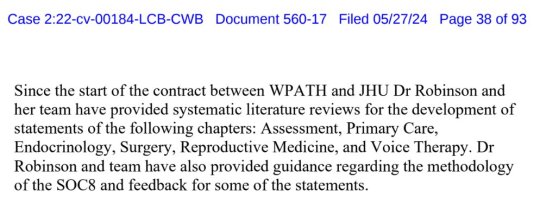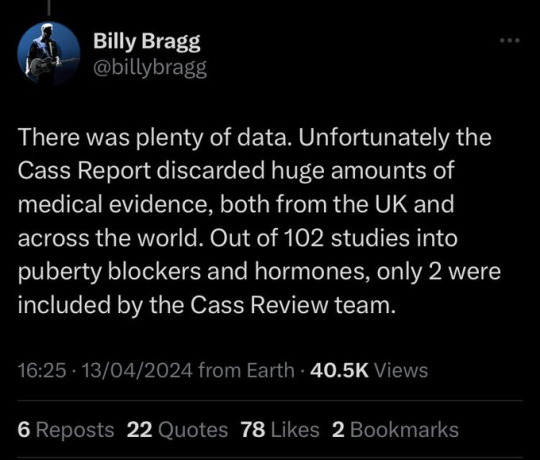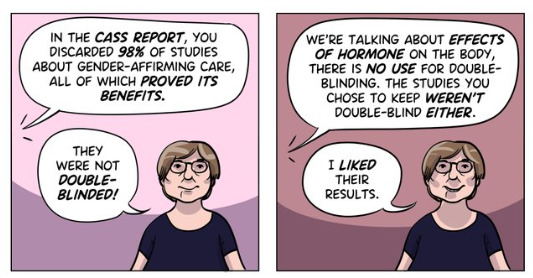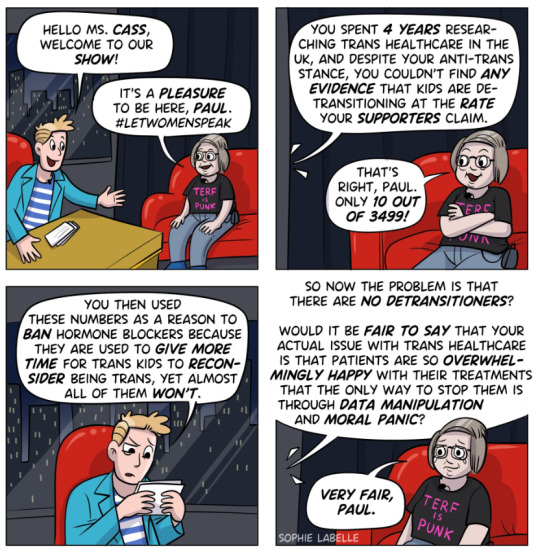#systematic review
Explore tagged Tumblr posts
Text
By: Jesse Singal
Published: Jun 27, 2024
In April Hilary Cass, a British paediatrician, published her review of gender-identity services for children and young people, commissioned by NHS England. It cast doubt on the evidence base for youth gender medicine. This prompted the World Professional Association for Transgender Health (WPATH), the leading professional organisation for the doctors and practitioners who provide services to trans people, to release a blistering rejoinder. WPATH said that its own guidelines were sturdier, in part because they were “based on far more systematic reviews”.
Systematic reviews should evaluate the evidence for a given medical question in a careful, rigorous manner. Such efforts are particularly important at the moment, given the feverish state of the American debate on youth gender medicine, which is soon to culminate in a Supreme Court case challenging a ban in Tennessee. The case turns, in part, on questions of evidence and expert authority.
Court documents recently released as part of the discovery process in a case involving youth gender medicine in Alabama reveal that WPATH's claim was built on shaky foundations. The documents show that the organisation’s leaders interfered with the production of systematic reviews that it had commissioned from the Johns Hopkins University Evidence-Based Practice Centre (EPC) in 2018.
From early on in the contract negotiations, WPATH expressed a desire to control the results of the Hopkins team’s work. In December 2017, for example, Donna Kelly, an executive director at PATH, told Karen Robinson, the EPC's director, that the WPATH board felt the EPC researchers “cannot publish their findings independently”. A couple of weeks later, Ms Kelly emphasised that, “the [WPATH] board wants it to be clear that the data cannot be used without WPATH approval”.
Ms Robinson saw this as an attempt to exert undue influence over what was supposed to be an independent process. John Ioannidis of Stanford University, who co-authored guidelines for systematic reviews, says that if sponsors interfere or are allowed to veto results, this can lead to either biased summaries or suppression of unfavourable evidence. Ms Robinson sought to avoid such an outcome. “In general, my understanding is that the university will not sign off on a contract that allows a sponsor to stop an academic publication,” she wrote to Ms Kelly.
Months later, with the issue still apparently unresolved, Ms Robinson adopted a sterner tone. She noted in an email in March 2018 that, “Hopkins as an academic institution, and I as a faculty member therein, will not sign something that limits academic freedom in this manner,” nor “language that goes against current standards in systematic reviews and in guideline development”.
Not to reason XY
Eventually WPATH relented, and in May 2018 Ms Robinson signed a contract granting WPATH power to review and offer feedback on her team’s work, but not to meddle in any substantive way. After WPATH leaders saw two manuscripts submitted for review in July 2020, however, the parties’ disagreements flared up again. In August the WPATH executive committee wrote to Ms Robinson that WPATH had “many concerns” about these papers, and that it was implementing a new policy in which WPATH would have authority to influence the EPC team’s output—including the power to nip papers in the bud on the basis of their conclusions.
Ms Robinson protested that the new policy did not reflect the contract she had signed and violated basic principles of unfettered scientific inquiry she had emphasised repeatedly in her dealings with WPATH. The Hopkins team published only one paper after WPATH implemented its new policy: a 2021 meta-analysis on the effects of hormone therapy on transgender people. Among the recently released court documents is a WPATH checklist confirming that an individual from WPATH was involved “in the design, drafting of the article and final approval of [that] article”. (The article itself explicitly claims the opposite.) Now, more than six years after signing the agreement, the EPC team does not appear to have published anything else, despite having provided WPATH with the material for six systematic reviews, according to the documents.
No one at WPATH or Johns Hopkins has responded to multiple inquiries, so there are still gaps in this timeline. But an email in October 2020 from WPATH figures, including its incoming president at the time, Walter Bouman, to the working group on guidelines, made clear what sort of science WPATH did (and did not) want published. Research must be “thoroughly scrutinised and reviewed to ensure that publication does not negatively affect the provision of transgender health care in the broadest sense,” it stated. Mr Bouman and one other coauthor of that email have been named to a World Health Organisation advisory board tasked with developing best practices for transgender medicine.
Another document recently unsealed shows that Rachel Levine, a transwoman who is assistant secretary for health, succeeded in pressing WPATH to remove minimum ages for the treatment of children from its 2022 standards of care. Dr Levine’s office has not commented. Questions remain unanswered, but none of this helps WPATH’s claim to be an organisation that bases its recommendations on science.
[ Via: https://archive.today/wJCI7 ]
--













==
So, there are 6 completed reviews sitting somewhere, that WPATH knows shows undesirable (to them) results. And they know it. And despite - or perhaps, because of - that, they wrote the insane SOC8 anyway. And then, at the behest of Rachel Levine, went back and took out the age limits, making it even more insane.
This isn't how science works, it's how a cult works.
When John Templeton Foundation commissioned a study on the efficacy of intercessory prayer, a study which unsurprisingly found that it's completely ineffective, it was forced to publish the negative results.
So, even the religious are more ethical than gender ideologues when it comes to science. This is outright scientific corruption.
#Jesse Singal#Johns Hopkins#Johns Hopkins University#WPATH#World Professional Association for Transgender Health#anti science#gender cult#corruption#medical malpractice#medical corruption#medical scandal#systematic review#Cass review#Cass report#gender affirming care#gender affirming healthcare#gender affirmation#ideological corruption#religion is a mental illness
275 notes
·
View notes
Link
#Drought#Systematic review#Environment management#Community development#Climate change adaptation#Asian farmers
1 note
·
View note
Text
as i approach 2000/9500 articles screened, here are some things i think we need to stop researching immediately as there is plenty of fucking research on it
colorectal can screening
physical activity
pregnant women getting vaccinated
0 notes
Text
Multiple sclerosis: global health and access to essential healthcare
A personal PoV on issues of #globalhelath and #evidencebasedmedicine in the context of #multiplesclerosis #MRI and #access to #essentialmedicines #MS #MSIF #WHO #Cochrane
‘Global faces of MS’ video, by the MS International Federation (MSIF) Neurological problems are something that can effect anybody, impacting at least 1 in 3 people at some point in their lives [1]. The experience of having neurological disorder and receiving appropriate healthcare can differ due to different factors, and a lot can depend on where you are located. There are many factors that…
#Cochrane#Evidence based medicine#evidence synthesis#Global Health#meta-analysis#MRI#MSIF#Multiple Sclerosis#My Research#neurology#systematic review
0 notes
Text
I hadn't been reading much lately and couldn't figure out why. It just hit me today.
I haven't been spending hours reading books for fun because I've been spending hours reading hundreds of scientific articles on medical errors and mental healthcare access for teens for a scoping review and a systematic review for work.
So, I've been reading, just not the fun, relaxing kind of reading.
1 note
·
View note
Text
Cara Kelola Data untuk Systematic Review dan Meta-Analisis dengan Cochrane RevMan Web
Nazroel.id – Systematic review dan meta-analisis adalah metode penelitian yang mengintegrasikan hasil dari berbagai studi untuk mendapatkan kesimpulan yang lebih kuat dan menyeluruh. Proses ini melibatkan pengumpulan, pengelolaan, dan analisis data secara hati-hati. Cochrane RevMan Web adalah alat yang sangat berguna untuk mengelola dan menganalisis data ini. Berikut adalah panduan langkah demi…

View On WordPress
0 notes
Text
https://onlinelibrary.wiley.com/doi/pdf/10.1111/nmo.14698
Sufferers of irritable bowl syndrome (any kind) do not appear to have any reduced dietary intake of macro- or micro-nutrients compared to the general population, apart from vitamin D and fibre.
That being said, if you have IBS, be sure to consult with your physician/dietician before changing your diet.
#doctor disinformation#doctordisinformation#just ibs things#research#education#meta analysis#systematic review
0 notes
Text
Key findings from our systematic review on antimicrobial stewardship (AMS) in hospitals over the past two decades highlight the need for strong AMS practices post-pandemic to ensure patient safety and combat AMR. Key recommendations:
1. Multidisciplinary teams
2. Core strategies first
3. Tailored interventions
4. Prospective audit & feedback
5. Guidelines & education
6. National prescribing indicators
7. Novel measures like procalcitonin-guided prescribing
8. Standardised AMS measures
9. Technical support systems
These insights provide a roadmap for better AMS practices and patient outcomes.
#AntimicrobialStewardship #PatientSafety #HealthcareInnovation #InfectionControl #PublicHealth

#antibiotics#antimicrobial resistance#public health#healthcare#clinical research#world health organization#systematic review
0 notes
Text
Should You Invest In SIP?
Over the past five years, the stock market has witnessed an unprecedented surge in investor participation, with the majority favoring mutual funds as their investment vehicle of choice. Within this realm, the Systematic Investment Plan (SIP) has emerged as a game-changing strategy, captivating investors with its disciplined approach and promising returns. Let’s unravel the secrets behind SIP and understand why it stands out as the most effective way to navigate the dynamic landscape of mutual fund investing.

Why SIP? A Gateway to Financial Discipline:
One of the most significant challenges individuals face is saving money consistently. SIP tackles this issue head-on by instilling financial discipline through regular, automated investments. By committing to investing at regular intervals each month, SIP ensures that saving becomes a priority before discretionary spending.
Start Small, Dream Big:
One of the remarkable features of SIP is its accessibility. With an entry point as low as INR 500 per month, even individuals with modest earnings or limited savings can participate in the growth of the Indian stock market. SIP plans across various mutual funds open doors to wealth creation for a diverse range of investors.
Timing Stress? Not with SIP:
Unlike attempting to time the market, a daunting task even for seasoned investors, SIP alleviates the stress associated with market timing. Through the power of averaging, investors benefit whether the market is at its peak or in a downturn. The consistent investment intervals ensure a balanced portfolio over time.
Compounding Magic:
SIP harnesses the magic of compounding by reinvesting monthly returns until maturity. This compounding effect leads to exponential growth in your investment over time. The longer you stay invested, the greater the impact of compounding on your wealth.
Flexibility and Freedom:
SIP offers unparalleled flexibility, allowing investors to stop their plans at any point without incurring penalties. This freedom contrasts sharply with traditional investments like Fixed Deposits or Recurring Deposits, providing investors with control over their financial decisions.
Skip a Month, No Worries:
Life is unpredictable, and financial constraints may arise. SIP understands this reality, allowing investors to skip a month without penalties. This feature distinguishes SIP from rigid investment options, offering breathing room during challenging times.
Scaling Up with Extra Income:
As your financial situation evolves, SIP provides a seamless way to scale up your investments. If you find yourself with additional disposable income, starting another SIP plan in different mutual funds diversifies your portfolio and maximizes returns.
Emotion-Free Investing:
Emotions have no place in successful investing. SIP introduces discipline, steering investors away from impulsive decisions driven by market fluctuations. By sticking to a systematic approach, investors shield themselves from short-term volatility and emotional reactions.
Past Performance: A Glimpse into the Future:
The success stories of SIP investors speak volumes. Consider a SIP of ₹3000 per month in HDFC Top 200 initiated in 1999. Over 15 years, a total investment of ₹5.4 lakh burgeoned into almost ₹35 lakh. Similarly, Franklin India Prima Plus, with the same SIP amount, turned ₹5.4 lakh into nearly ₹31 lakh in 15 years. These examples underscore the long-term wealth-building potential of SIP.
Key Takeaways: Mastering the Art of SIP Investing:
1. Discipline is the Key:
- SIP embodies disciplined investing, promoting consistency over time.
2. Diversification through Multiple SIPs:
- Investors can diversify their portfolio by initiating SIPs in two or more funds.
3. Tax Benefits with SIPs:
- Certain SIP investments are eligible for tax deductions under Section 80C of the Income Tax Act, providing an additional financial incentive.
4. Harness the Power of Compounding:
- To fully benefit from compounding, it’s crucial to hold onto investments for an extended period.
5. Start Early, Stay Committed:
- Beginning your SIP journey early is akin to planting the seeds of wealth. Patience is key, and the earlier you start, the more significant your financial harvest.
Conclusion:
In the ever-evolving landscape of financial markets, SIP emerges as a beacon of financial prudence and growth. Its ability to instill discipline, coupled with the flexibility it offers, makes SIP a powerful tool for investors of all levels. As we navigate the complexities of wealth creation, SIP stands as a testament to the idea that consistent, disciplined investing is the cornerstone of financial success. So, embark on your SIP journey, stay committed, and let the power of compounding pave the way for a prosperous financial future.
For more information or To open Trading / Demat Account — Visit our Website 👩💻 𝐰𝐰𝐰.𝐢𝐧𝐯𝐞𝐬𝐭𝐦𝐞𝐧𝐭𝐨𝐫𝐨𝐧𝐥𝐢𝐧𝐞.𝐜𝐨𝐦 To talk to our expert team — Call us ☎️ +𝟗𝟏 𝟕𝟗𝟔𝟗𝟏 𝟓𝟑𝟔𝟎𝟎
#stock market#investing#sip investment#systematic investment plan#finance#systematic review#investmentor#stocks news#savings#wealth management#share market#investing stocks#bse#nse#indian stock market#tradinginsights#smart investing#financial planning#passive income#financial strategy#personal finance#investmentor securities#forex trading#forex education#forexmarket
0 notes
Text

By: Andy L.
Published: Apr 14, 2024
It has now been just little under a week since the publication of the long anticipated NHS independent review of gender identity services for children and young people, the Cass Review.
The review recommends sweeping changes to child services in the NHS, not least the abandonment of what is known as the “affirmation model” and the associated use of puberty blockers and, later, cross-sex hormones. The evidence base could not support the use of such drastic treatments, and this approach was failing to address the complexities of health problems in such children.
Many trans advocacy groups appear to be cautiously welcoming these recommendations. However, there are many who are not and have quickly tried to condemn the review. Within almost hours, “press releases“, tweets and commentaries tried to rubbish the report and included statements that were simply not true. An angry letter from many “academics”, including Andrew Wakefield, has been published. These myths have been subsequently spreading like wildfire.
Here I wish to tackle some of those myths and misrepresentations.
-
Myth 1: 98% of all studies in this area were ignored


Fact
A comprehensive search was performed for all studies addressing the clinical questions under investigation, and over 100 were discovered. All these studies were evaluated for their quality and risk of bias. Only 2% of the studies met the criteria for the highest quality rating, but all high and medium quality (50%+) studies were further analysed to synthesise overall conclusions.
Explanation
The Cass Review aimed to base its recommendations on the comprehensive body of evidence available. While individual studies may demonstrate positive outcomes for the use of puberty blockers and cross-sex hormones in children, the quality of these studies may vary. Therefore, the review sought to assess not only the findings of each study but also the reliability of those findings.
Studies exhibit variability in quality. Quality impacts the reliability of any conclusions that can be drawn. Some may have small sample sizes, while others may involve cohorts that differ from the target patient population. For instance, if a study primarily involves men in their 30s, their experiences may differ significantly from those of teenage girls, who constitute the a primary patient group of interest. Numerous factors can contribute to poor study quality.
Bias is also a big factor. Many people view claims of a biased study as meaning the researchers had ideological or predetermined goals and so might misrepresent their work. That may be true. But that is not what bias means when we evaluate medical trials.
In this case we are interested in statistical bias. This is where the numbers can mislead us in some way. For example, if your study started with lots of patients but many dropped out then statistical bias may creep in as your drop-outs might be the ones with the worst experiences. Your study patients are not on average like all the possible patients.
If then we want to look at a lot papers to find out if a treatment works, we want to be sure that we pay much more attention to those papers that look like they may have less risk of bias or quality issues. The poor quality papers may have positive results that are due to poor study design or execution and not because the treatment works.
The Cass Review team commissioned researchers at York University to search for all relevant papers on childhood use of puberty blockers and cross-sex hormones for treating “gender dysphoria”. The researchers then graded each paper by established methods to determine quality, and then disregarded all low quality papers to help ensure they did not mislead.
The Review states,
The systematic review on interventions to suppress puberty (Taylor et al: Puberty suppression) provides an update to the NICE review (2020a). It identified 50 studies looking at different aspects of gender-related, psychosocial, physiological and cognitive outcomes of puberty suppression. Quality was assessed on a standardised scale. There was one high quality study, 25 moderate quality studies and 24 low quality studies. The low quality studies were excluded from the synthesis of results.
As can be seen, the conclusions that were based on the synthesis of studies only rejected 24 out of 50 studies – less than half. The myth has arisen that the synthesis only included the one high quality study. That is simply untrue.
There were two such literature reviews: the other was for cross-sex hormones. This study found 19 out of 53 studies were low quality and so were not used in synthesis. Only one study was classed as high quality – the rest medium quality and so were used in the analysis.
12 cohort, 9 cross-sectional and 32 pre–post studies were included (n=53). One cohort study was high-quality. Other studies were moderate (n=33) and low-quality (n=19). Synthesis of high and moderate-quality studies showed consistent evidence demonstrating induction of puberty, although with varying feminising/masculinising effects. There was limited evidence regarding gender dysphoria, body satisfaction, psychosocial and cognitive outcomes, and fertility.
Again, it is myth that 98% of studies were discarded. The truth is that over a hundred studies were read and appraised. About half of them were graded to be of too poor quality to reliably include in a synthesis of all the evidence. if you include low quality evidence, your over-all conclusions can be at risk from results that are very unreliable. As they say – GIGO – Garbage In Garbage Out.
Nonetheless, despite analysing the higher quality studies, there was no clear evidence that emerged that puberty blockers and cross-sex hormones were safe and effective. The BMJ editorial summed this up perfectly,
One emerging criticism of the Cass review is that it set the methodological bar too high for research to be included in its analysis and discarded too many studies on the basis of quality. In fact, the reality is different: studies in gender medicine fall woefully short in terms of methodological rigour; the methodological bar for gender medicine studies was set too low, generating research findings that are therefore hard to interpret. The methodological quality of research matters because a drug efficacy study in humans with an inappropriate or no control group is a potential breach of research ethics. Offering treatments without an adequate understanding of benefits and harms is unethical. All of this matters even more when the treatments are not trivial; puberty blockers and hormone therapies are major, life altering interventions. Yet this inconclusive and unacceptable evidence base was used to inform influential clinical guidelines, such as those of the World Professional Association for Transgender Health (WPATH), which themselves were cascaded into the development of subsequent guidelines internationally.
-
Myth 2: Cass recommended no Trans Healthcare for Under 25s

Fact
The Cass Review does not contain any recommendation or suggestion advocating for the withholding of transgender healthcare until the age of 25, nor does it propose a prohibition on individuals transitioning.
Explanation
This myth appears to be a misreading of one of the recommendations.
The Cass Review expressed concerns regarding the necessity for children to transition to adult service provision at the age of 18, a critical phase in their development and potential treatment. Children were deemed particularly vulnerable during this period, facing potential discontinuity of care as they transitioned to other clinics and care providers. Furthermore, the transition made follow-up of patients more challenging.
Cass then says,
Taking account of all the above issues, a follow-through service continuing up to age 25 would remove the need for transition at this vulnerable time and benefit both this younger population and the adult population. This will have the added benefit in the longer-term of also increasing the capacity of adult provision across the country as more gender services are established.
Cass want to set up continuity of service provision by ensure they remain within the same clinical setting and with the same care providers until they are 25. This says nothing about withdrawing any form of treatment that may be appropriate in the adult care pathway. Cass is explicit in saying her report is making no recommendations as to what that care should look like for over 18s.
It looks the myth has arisen from a bizarre misreading of the phrase “remove the need for transition”. Activists appear to think this means that there should be no “gender transition” whereas it is obvious this is referring to “care transition”.
-
Myth 3: Cass is demanding only Double Blind Randomised Controlled Trials be used as evidence in “Trans Healthcare”

Fact
While it is acknowledged that conducting double-blind randomized controlled trials (DBRCT) for puberty blockers in children would present significant ethical and practical challenges, the Cass Review does not advocate solely for the use of DBRCT trials in making treatment recommendations, nor does it mandate that future trials adhere strictly to such protocols. Rather, the review extensively discusses the necessity for appropriate trial designs that are both ethical and practical, emphasizing the importance of maintaining high methodological quality.
Explanation
Cass goes into great detail explaining the nature of clinical evidence and how that can vary in quality depending on the trial design and how it is implemented and analysed. She sets out why Double Blind Randomised Controlled Trials are the ‘gold standard’ as they minimise the risks of confounding factors misleading you and helping to understand cause and effect, for example. (See Explanatory Box 1 in the Report).
Doctors rely on evidence to guide treatment decisions, which can be discussed with patients to facilitate informed choices considering the known benefits and risks of proposed treatments.
Evidence can range from a doctor’s personal experience to more formal sources. For instance, a doctor may draw on their own extensive experience treating patients, known as ‘Expert Opinion.’ While valuable, this method isn’t foolproof, as historical inaccuracies in medical beliefs have shown.
Consulting other doctors’ experiences, especially if documented in published case reports, can offer additional insight. However, these reports have limitations, such as their inability to establish causality between treatment and outcome. For example, if a patient with a bad back improves after swimming, it’s uncertain whether swimming directly caused the improvement or if the back would have healed naturally.
Further up the hierarchy of clinical evidence are papers that examine cohorts of patients, typically involving multiple case studies with statistical analysis. While offering better evidence, they still have potential biases and limitations.
This illustrates the ‘pyramid of clinical evidence,’ which categorises different types of evidence based on their quality and reliability in informing treatment decisions

The above diagram is published in the Cass Review as part of Explanatory Box 1.
We can see from the report and papers that Cass did not insist that only randomised controlled trials were used to assess the evidence. The York team that conducted the analyses chose a method to asses the quality of studies called the Newcastle Ottawa Scale. This is a method best suited for non RCT trials. Cass has selected an assessment method best suited for the nature of the available evidence rather than taken a dogmatic approach on the need for DBRCTs. The results of this method were discussed about countering Myth 1.
Explainer on the Newcastle Ottawa Scale
The Newcastle-Ottawa Scale (NOS) is a tool designed to assess the quality of non-randomized studies, particularly observational studies such as cohort and case-control studies. It provides a structured method for evaluating the risk of bias in these types of studies and has become widely used in systematic reviews and meta-analyses.
The NOS consists of a set of criteria grouped into three main categories: selection of study groups, comparability of groups, and ascertainment of either the exposure or outcome of interest. Each category contains several items, and each item is scored based on predefined criteria. The total score indicates the overall quality of the study, with higher scores indicating lower risk of bias.
This scale is best applied when conducting systematic reviews or meta-analyses that include non-randomized studies. By using the NOS, researchers can objectively assess the quality of each study included in their review, allowing them to weigh the evidence appropriately and draw more reliable conclusions.
One of the strengths of the NOS is its flexibility and simplicity. It provides a standardized framework for evaluating study quality, yet it can be adapted to different study designs and research questions. Additionally, the NOS emphasizes key methodological aspects that are crucial for reducing bias in observational studies, such as appropriate selection of study participants and controlling for confounding factors.
Another advantage of the NOS is its widespread use and acceptance in the research community. Many systematic reviews and meta-analyses rely on the NOS to assess the quality of included studies, making it easier for researchers to compare and interpret findings across different studies.
As for future studies, Cass makes no demand only DBRCTs are conducted. What is highlighted is at the very least that service providers build a research capacity to fill in the evidence gaps.
The national infrastructure should be put in place to manage data collection and audit and this should be used to drive continuous quality improvement and research in an active learning environment.
-
Myth 4: There were less than 10 detransitioners out of 3499 patients in the Cass study.


Fact
Cass was unable to determine the detransition rate. Although the GIDS audit study recorded fewer than 10 detransitioners, clinics declined to provide information to the review that would have enabled linking a child’s treatment to their adult outcome. The low recorded rates must be due in part to insufficient data availability.
Explanation
Cass says, “The percentage of people treated with hormones who subsequently detransition remains unknown due to the lack of long-term follow-up studies, although there is suggestion that numbers are increasing.”
The reported number are going to be low for a number of reasons, as Cass describes:
Estimates of the percentage of individuals who embark on a medical pathway and subsequently have regrets or detransition are hard to determine from GDC clinic data alone. There are several reasons for this:
Damningly, Cass describes the attempt by the review to establish “data linkage’ between records at the childhood gender clinics and adult services to look at longer term detransition and the clinics refused to cooperate with the Independent Review. The report notes the “…attempts to improve the evidence base have been thwarted by a lack of cooperation from the adult gender services”.
We know from other analyses of the data on detransitioning that the quality of data is exceptionally poor and the actual rates of detransition and regret are unknown. This is especially worrying when older data, such as reported in WPATH 7, suggest natural rates of decrease in dysphoria without treatment are very high.
Gender dysphoria during childhood does not inevitably continue into adulthood. Rather, in follow-up studies of prepubertal children (mainly boys) who were referred to clinics for assessment of gender dysphoria, the dysphoria persisted into adulthood for only 6–23% of children.
This suggests that active affirmative treatment may be locking in a trans identity into the majority of children who would otherwise desist with trans ideation and live unmedicated lives.
I shall add more myths as they become spread.
==
It's not so much "myths and misconceptions" as deliberate misinformation. Genderists are scrambling to prop up their faith-based beliefs the same way homeopaths do. Both are fraudulent.
#Andy L.#Cass Review#Cass Report#Dr. Hilary Cass#Hilary Cass#misinformation#myths#misconceptions#detrans#detransition#gender affirming healthcare#gender affirming care#gender affirmation#affirmation model#medical corruption#medical malpractice#medical scandal#systematic review#religion is a mental illness
387 notes
·
View notes
Text

Doctor of Business Administration
#Doctor of Business Administration#DBA#topicselection#questionnaire#statistical analysis#research paper#synopsis#academic writing#editing#systematic review
1 note
·
View note
Link
1 note
·
View note
Text
sorry for my persistent belief that economists can't write. i am not wrong but it's definitely meanspirited of me. anyway you can immediately tell if a paper is written by a historian of economics vs. an economist with historical interests, on account of: the prose is So bad
#this is true even in papers in translation but i'm not confident enough to try reading straight french economics papers. jargon.#economists & political scientists in the united states both have this terrible style? it's less true the more heterodox they are#someone should write a paper explaining where this specific register came from#not sure what to call it but let's coin a phrase. they love coining phrases. graphs chic? trying to sound like they know calculus prose?#econosentences. efficiency text. it's not quite corporate but it's like two small steps away from harvard business review#some lawyers do it too actually now that i'm thinking about it. there's a certain way of trying to systematize information i think#yes every discipline has its register but let's be mean to economists. my beautiful girlfriend is currently suffering in economics class.#classical economists could write just fine & keynes has some bangers so idk why this happened. there are social scientists who are OK!
8 notes
·
View notes
Text
My Brain [citation needed]
Something read and reviewed, and something reviewed and published (and read, hopefully) #books #reviews #systematicreviews #multiplesclerosis
Something I Read I recently read The Girl With All the Gifts, (2014) by Mike Carey, an author that I know better from their comics work. In particular, Lucifer, which follows the titular character after they quit their day job as Hell’s boss in Neil Gaiman’s Sandman, is a series I’ve come back to time and time again. Here we have Carey’s take on the zombie apocalypse which they attack with…

View On WordPress
#Cochrane#Mike Carey#Multiple Sclerosis#My Research#systematic review#Your Brain on...Books#Your Brain On...Comics#zombie
1 note
·
View note
Text
youtube
Is Your Evidence Really Based? Behaviourist Capture, Autistic Self-Advocacy, and Librarianship
In the history of science and medicine there are numerous examples of how the “best available evidence” promoted by professional societies was profoundly, destructively wrong. This can be seen in the widespread support of scientific racism and eugenics as well as the pathologization of “sexual inversion” and gender variance. When, as librarians, we talk about the nature of authority and hold up peer review as an example of a methodological gold standard in academic and medical research, we must always ask ourselves: whose peers are we talking about? For that matter, whose interests are we talking about? It is becoming increasingly evident even to those outside the autistic community that despite claims of being grounded in evidence-based practices, most studies on the effectiveness of Applied Behavioral Analysis (ABA) are poorly designed, do not disclose conflicts of interest, display a strategic disregard of the harmful outcomes of interventions, and do not reflect the interests of the majority of autistic people. At best, ABA is expensive, intensive, and ineffective at improving life outcomes. At worst, it is actively traumatic and makes us more susceptible to further victimization.
This discussion will examine recent challenges to the evidence-based nature of ABA and how ABA practitioners have historically taken advantage of the internalist nature of the peer-review system. These challenges reinforce what autistic activists have been saying for over twenty years and have consequences for how librarians deliver information literacy instruction. Information literacy and librarianship are not neutral activities and must include a place for own voice narratives, patient, and survivor accounts if we are to avoid perpetuating harmful industry standards with a shrug and a gesture to how “well, everyone’s doing it.”
7 notes
·
View notes
Text
I screened 4,292 articles.. I can screen another 386......
#momo.exe#can i tho#fucking can i#im sick of this#never doing systematic reviews again#i cant wait to graduate and delete endnote
2 notes
·
View notes